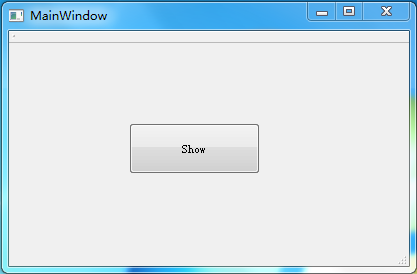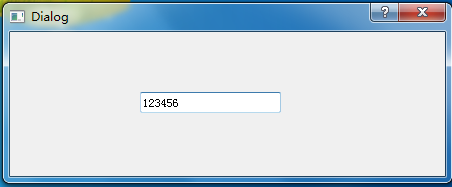Qt信号之自定义数据类型
【1】为什么需要自定义数据类型?
内置类型毕竟很有局限性,否则为什么还需要类呢。总之,有时候,我们多么希望信号能发送自定义数据类型。
幸哉~ Qt是支持自定义信号,且自定义信号可以发送自定义数据类型的对象。
【2】使用方法(声明 和 注册自定义数据类型)
1)引入头文件:#include<QMetaType>
2)添加声明:利用宏 Q_DECLARE_METATYPE
3)注册:利用方法 qRegisterMetaType
【3】实例Demo
1.文件目录(为了更好的模拟现实项目的需求,示例程序逻辑比较复杂)

2.pro文件
#-------------------------------------------------
#
# Project created by QtCreator --27T21::
#
#------------------------------------------------- QT += core gui greaterThan(QT_MAJOR_VERSION, ): QT += widgets TARGET = CustomDataType
TEMPLATE = app DEFINES += QT_DEPRECATED_WARNINGS SOURCES += main.cpp\
MyDialog.cpp \
MainWindow.cpp HEADERS += \
MyDialog.h \
MainWindow.h FORMS += \
MyDialog.ui \
MainWindow.ui
3.MyDialog.h(自定义数据类型CustomDataType,使用宏Q_DECLARE_METATYPE声明数据类型)
#ifndef MYDIALOG_H
#define MYDIALOG_H #include <QDialog>
#include <QMetaType> namespace Ui
{
class MyDialog;
} class CustomDataType
{
public:
CustomDataType(int n = ) : m_nValue(n) {}
~CustomDataType() {}
int getValue() const { return m_nValue; }
void setValue(int nValue) { m_nValue = nValue; } private:
int m_nValue;
}; class MyDialog : public QDialog
{
Q_OBJECT public:
explicit MyDialog(QWidget *parent = );
~MyDialog(); public slots:
void onTextChanged(const QString &str); signals:
void postData(const CustomDataType &data); protected:
void closeEvent(QCloseEvent *event); private:
Ui::MyDialog *m_pUI;
CustomDataType m_data;
}; Q_DECLARE_METATYPE(CustomDataType) #endif // MYDIALOG_H
4.MyDialog.cpp(构造函数中利用qRegisterMetaType注册自定义数据类型)
#include "MyDialog.h"
#include "ui_MyDialog.h" MyDialog::MyDialog(QWidget *parent) :
QDialog(parent),
m_pUI(new Ui::MyDialog)
{
m_pUI->setupUi(this);
qRegisterMetaType<CustomDataType>("CustomDataType"); connect(m_pUI->lineEdit, &QLineEdit::textChanged, this, &MyDialog::onTextChanged);
} MyDialog::~MyDialog()
{
if (m_pUI)
{
delete m_pUI;
m_pUI = Q_NULLPTR;
}
} void MyDialog::closeEvent(QCloseEvent *event)
{
emit postData(m_data);
QDialog::closeEvent(event);
} void MyDialog::onTextChanged(const QString & str)
{
bool bOK = false;
int nNumber = str.toInt(&bOK);
bOK ? m_data.setValue(nNumber) : m_data.setValue(-);
}
5.MainWindow.h(业务类中直接定义槽函数,利用自定义数据类型作为参数类型即可)
#ifndef MAINWINDOW_H
#define MAINWINDOW_H #include <QDebug>
#include <QMainWindow>
#include "MyDialog.h" namespace Ui
{
class MainWindow;
} class MainWindow : public QMainWindow
{
Q_OBJECT public:
explicit MainWindow(QWidget *parent = );
~MainWindow(); public slots:
void onPostData(const CustomDataType &data);
void onPushButtonPress(); private:
MyDialog m_dialog;
Ui::MainWindow *m_pUI;
}; #endif // MAINWINDOW_H
6.MainWindow.cpp(connect正常连接信号与槽,并定义槽函数)
#include "MainWindow.h"
#include "ui_mainwindow.h" MainWindow::MainWindow(QWidget *parent)
: QMainWindow(parent)
, m_pUI(new Ui::MainWindow)
{
m_pUI->setupUi(this);
connect(&m_dialog, &MyDialog::postData, this, &MainWindow::onPostData);
connect(m_pUI->pushButton, &QPushButton::pressed, this, &MainWindow::onPushButtonPress);
} MainWindow::~MainWindow()
{
if (m_pUI)
{
delete m_pUI;
m_pUI = Q_NULLPTR;
}
} void MainWindow::onPostData(const CustomDataType &data)
{
m_pUI->pushButton->setText(QString::number(data.getValue()));
} void MainWindow::onPushButtonPress()
{
m_dialog.show();
}
7.main.cpp
#include "MainWindow.h"
#include <QApplication> int main(int argc, char *argv[])
{
QApplication a(argc, argv);
MainWindow w;
w.show(); return a.exec();
}
8.ui文件请自理。
【4】运行效果图
按顺序图1->图2->图3
图1:弹出主窗体,主窗体中央部位放置一个PushButton,点击PushButton后,弹出图2对话框。

图2:对话框中间放置一个LineEdit,编辑数值123456,然后关闭对话框。

图3:当图2对话框被关闭时,会发送信号,信号会附加自定义数据类型的数据对象。
主窗体的响应槽函数从自定义数据对象中获取值,然后刷新PushButton文本为设置的数据值。

【5】源码剖析
1)宏 Q_DECLARE_METATYPE
源码如下。摘自版本路径(C:\Qt\Qt5.7.1\5.7\msvc2013\include\QtCore\qmetatype.h)
#define Q_DECLARE_METATYPE(TYPE) Q_DECLARE_METATYPE_IMPL(TYPE)
#define Q_DECLARE_METATYPE_IMPL(TYPE) \
QT_BEGIN_NAMESPACE \
template <> \
struct QMetaTypeId< TYPE > \
{ \
enum { Defined = }; \
static int qt_metatype_id() \
{ \
static QBasicAtomicInt metatype_id = Q_BASIC_ATOMIC_INITIALIZER(); \
if (const int id = metatype_id.loadAcquire()) \
return id; \
const int newId = qRegisterMetaType< TYPE >(#TYPE, \
reinterpret_cast< TYPE *>(quintptr(-))); \
metatype_id.storeRelease(newId); \
return newId; \
} \
}; \
QT_END_NAMESPACE #ifndef Q_BASIC_ATOMIC_INITIALIZER
# define Q_BASIC_ATOMIC_INITIALIZER(a) { (a) }
#endif
2) 模板函数qRegisterMetaType
源码如下。摘自版本路径(C:\Qt\Qt5.7.1\5.7\msvc2013\include\QtCore\qmetatype.h)
template <typename T>
int qRegisterMetaType(const char *typeName
#ifndef Q_QDOC
, T * dummy = Q_NULLPTR
, typename QtPrivate::MetaTypeDefinedHelper<T, QMetaTypeId2<T>::Defined && !QMetaTypeId2<T>::IsBuiltIn>::DefinedType defined =
QtPrivate::MetaTypeDefinedHelper<T, QMetaTypeId2<T>::Defined && !QMetaTypeId2<T>::IsBuiltIn>::Defined
#endif
)
{
#ifdef QT_NO_QOBJECT
QT_PREPEND_NAMESPACE(QByteArray) normalizedTypeName = typeName;
#else
QT_PREPEND_NAMESPACE(QByteArray) normalizedTypeName = QMetaObject::normalizedType(typeName);
#endif
return qRegisterNormalizedMetaType<T>(normalizedTypeName, dummy, defined);
} template<typename T, bool defined>
struct MetaTypeDefinedHelper
{
enum DefinedType { Defined = defined };
}; template <typename T>
int qRegisterNormalizedMetaType(const QT_PREPEND_NAMESPACE(QByteArray) &normalizedTypeName
#ifndef Q_QDOC
, T * dummy =
, typename QtPrivate::MetaTypeDefinedHelper<T, QMetaTypeId2<T>::Defined && !QMetaTypeId2<T>::IsBuiltIn>::DefinedType defined =
QtPrivate::MetaTypeDefinedHelper<T, QMetaTypeId2<T>::Defined && !QMetaTypeId2<T>::IsBuiltIn>::Defined
#endif
)
{
#ifndef QT_NO_QOBJECT
Q_ASSERT_X(normalizedTypeName == QMetaObject::normalizedType(normalizedTypeName.constData()),
"qRegisterNormalizedMetaType",
"qRegisterNormalizedMetaType was called with a not normalized type name, please call qRegisterMetaType instead.");
#endif
const int typedefOf = dummy ? - : QtPrivate::QMetaTypeIdHelper<T>::qt_metatype_id();
if (typedefOf != -)
return QMetaType::registerNormalizedTypedef(normalizedTypeName, typedefOf); QMetaType::TypeFlags flags(QtPrivate::QMetaTypeTypeFlags<T>::Flags); if (defined)
flags |= QMetaType::WasDeclaredAsMetaType; const int id = QMetaType::registerNormalizedType(normalizedTypeName,
QtMetaTypePrivate::QMetaTypeFunctionHelper<T>::Destruct,
QtMetaTypePrivate::QMetaTypeFunctionHelper<T>::Construct,
int(sizeof(T)),
flags,
QtPrivate::MetaObjectForType<T>::value()); if (id > )
{
QtPrivate::SequentialContainerConverterHelper<T>::registerConverter(id);
QtPrivate::AssociativeContainerConverterHelper<T>::registerConverter(id);
QtPrivate::MetaTypePairHelper<T>::registerConverter(id);
QtPrivate::MetaTypeSmartPointerHelper<T>::registerConverter(id);
} return id;
}
详细内容。
Good Good Study,Day Day Up.
顺序 选择 循环 总结
Qt信号之自定义数据类型的更多相关文章
- 如何在Qt中使用自定义数据类型
这里我们使用下面这个struct来做说明(这里不管是struct还是class都一样): struct Player { int number; QString firstName; QString ...
- QT 信号槽connect中解决自定义数据类型或数组作为函数参数的问题——QT qRegisterMetaType 注册MetaType——关键:注册自定义数据类型或QMap等容器类
一般情况下信号槽直接连接方式不会出现问题,但是如果信号与槽在不同线程或Qt::QueuedConnection方式连接,可能会在连接期间报以下类似问题,如: QObject::connect: Can ...
- Qt之创建自定义类型
摘要: 简述 当使用Qt创建用户界面时,特别是那些带有特殊控制和特征的界面时,开发者通常需要创建新数据类型来扩展或替换Qt现有的的值类型集合. 标准类型,比如:QSize.QColor和QString ...
- QT信号和槽
QT信号和槽 ============ 信号和槽是一种高级接口,应用于对象之间的通信,它是 QT 的核心特性.要正确的处理信号和槽,必须借助一个称为 moc(Meta Object Compiler) ...
- 转: Qt信号槽实现原理 清晰明了
转: https://blog.csdn.net/perfectguyipeng/article/details/78082360 本文使用 ISO C++ 一步一步实现了一个极度简化的信号与槽的系统 ...
- QT信号槽详解
1 QT信号槽详解 1.1 信号和槽的定义 信号是触发信号,例如按钮的点击触发一个clicked信号,槽是用来接收信号,并处理信号,相当于信号响应函数.一个信号可以关联多个槽函数,信 ...
- 自定义数据类型使用QVariant转换的方法
QVariant类型的放入和取出必须是相对应的,你放入一个int就必须按int取出,不能用toString(), Qt不会帮你自动转换. 数据核心无非就是一个 union,和一个标记类型的type:传 ...
- Qt信号槽-原理分析
目录 一.问题 二.Moc 1.变量 2.Q_OBJECT展开后的函数声明 3.自定义信号 三.connect 四.信号触发 1.直连 2.队列连接 五.总结 六.推荐阅读 一.问题 学习Qt有一段时 ...
- QT使用提升自定义组件
QT使用提升自定义组件 QTC++QT自定义 QT 组件提升来实现自定义功能 介绍 我们在使用QT设置界面之后,往往需要自己实现一些方法,如果是单独 的还好,但是如果遇到很多同类型的都有需求, 比如 ...
随机推荐
- Dubbo服务化框架使用整理
一.垂直应用架构拆分 在应用架构的演进过程中,垂直应用架构因为开发便捷,学习成本低,对于实现业务功能的增删改查提供了高效的开发支持,有利于前期业务高速发展的的快速实现.但是随着系统业务功能的不断扩展和 ...
- 给予Java初学者的学习路线建议
va学习这一部分其实也算是今天的重点,这一部分用来回答很多群里的朋友所问过的问题,那就是你是如何学习Java的,能不能给点建议?今天我是打算来点干货,因此咱们就不说一些学习方法和技巧了,直接来谈每个阶 ...
- 【Mock】mock-server 环境搭建
前言 mock 除了用在单元测试过程中,还有一个用途,当前端开发在开发页面的时候,需要服务端提供 API 接口 此时服务端没开发完成,或者说没搭建测试环境,这个时候前端开发会自己 mock一个 api ...
- 弱网测试之基于TP-LINK
使用路由器做弱网测试应该是最真实的,网络工程师/运维工程师体会应该最深刻.这种方式测试成本也不高,比较推荐. 设置的方式不在赘述,参见使用手册,高级设置即可. 结束语: 这样测试的时候,测试机器连接该 ...
- mysql触发器:插入数据前更新创建时间为服务器的时间
DROP TRIGGER IF EXISTS `upd_patientquestionnaire`; create trigger upd_patientquestionnaire BEFORE in ...
- Python3学习之路~6.1 编程范式:面向过程 VS 面向对象
编程范式 编程是程序员用特定的语法+数据结构+算法组成的代码来告诉计算机如何执行任务的过程,一个程序是程序员为了得到一个任务结果而编写的一组指令的集合,正所谓条条大路通罗马,实现一个任务的方式有很多种 ...
- shell编程awk进阶
awk操作符 算术操作符: x+y, x-y, x*y, x/y, x^y, x%y -x: 转换为负数 +x: 转换为数值 字符串操作符:没有符号的操作符,字符串连接 赋值操作 ...
- 006-网页嵌入数据Data URI scheme
在项目css中或者图片展示中: url(data:image/png;base64,iVBORw0KGgoAAA 在RFC2397中定义的Data URI scheme,目的是将一些小的数据,直接嵌入 ...
- equals和contains的区别
equals只能判断两个变量的值是否相等.contains常用与集合中判断某个对象是否含有这个元素equals是需要两个对象完全相同才会返回true,而contains是要循环遍历容器里的所有内容后判 ...
- seller vue配置路径相对路径【组件 只写简单路径】
在[webpack.base.conf.js]配置 'components': path.resolve(__dirname, '../src/components')
